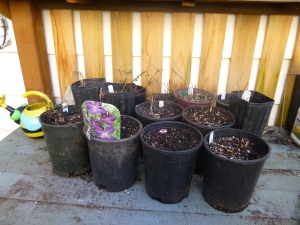Good Gravey, the garden is burdgeoning! Like Ellen DeGeneres (quoting Simon and Garfunkel), I want to say slow down, you move too fast. Whenever I’m at work, the day is perfect for gardening. When I’m off, it pours or it’s freezing like today. Geesh.

Students from the Clematis Pruning Workshop
Clematis Pruning Workshop
Last week I taught a Clematis Pruning Workshop in my garden with four students attending. I enjoyed it and learned new things myself! The eager students seemed to have a good time as well.
Pruning Group A (Early-Blooming, Small-Flowered Clematis)
First we walked around the garden looking at how various Pruning Group A clematis look in early spring. These clematis, which bloom between October and May, don’t usually need an annual prune.
We checked out my Clematis montana growing in a 90′ tall Port Orford cedar (it’s about 40′ or 50′ into the tree, which looks amazing when it blooms). We also inspected three evergreen New Zealand clematis that will show off their fragrant creamy white blossoms soon. Two Clematis cirrhosa, also evergreen, are growing in the garden, too, and one of them, Clematis cirrhosa ‘Freckles’ (see my February post highlighting this clematis), has been in bloom for over a month now. One of the most unusual Pruning Group A clematis I have is Clematis napaulensis, which is winter green (it goes dormant in the summer) and sports creamy white bells with red stamens in winter–mine is young and not blooming yet. But the majority of Pruning Group A clematis in my garden are various hybrids of Clematis alpina and Clematis macropetala, both of which have lovely nodding bells in many colors in April and May.
Comparing Early Spring Growth on Various Clematis

Clematis alpina (Pruning Group A)
We found that the Pruning Group A clematis (alpinas and macropetalas) and the large-flowered spring-blooming Pruning Group B clematis both had new leaf growth tight to the vine in early spring, and many were already showing flower buds. The leaves on the alpinas/macropetalas are more finely divided than those on the Pruning Gruop B clems. See photos. When compared to Pruning Group C clematis in my garden, which bloom on old wood, we found that the young growth on the Cs stretched out much further from the main vine and showed no signs of flower buds. These clematis are working to grow vines this time of year, while the As and Bs on the other hand devote their spring energy to producing flowers–they will throw vines after they finish blooming.

Clematis ‘Guernsey Cream’ (Pruning Group B)
Please note: these photos and comments represent observations of particular clematis in my garden and can’t really be used to identify which pruning group another clematis represents. If you don’t know what clematis you have or when it blooms, prune it lightly as for Pruning Group B (which will be described in my next post, coming soon) and wait to see when it blooms and what it looks like in order to identify it.

Clematis ‘Betty Corning’ (Pruning Group C)
The Actual Pruning
Pruning Group A clematis do not typically require an annual pruning. However, because most of them are large plants, they will eventually get into trouble and need to be pruned, very often after they have gotten large and unwieldy or when they are growing where they are not wanted. The best way to handle this situation is to prune shortly after the plant has finished blooming. I described the process to the group and had them practice on a large plant. They divided the plant into two parts — you have to be a bit rough to get the plant separated into two groups, but don’t worry, the plant will recover. Then they cut half of the plant back hard and left the other half to be pruned hard next year. This process has the two-fold advantages of ensuring that the plant won’t succomb to the hard pruning and maximizing bloom for the following spring.
We spent considerable time on Pruning Group B plants, which require much more detailed pruning (see my upcoming post for details). Additionally, the group pruned a large Pruning Group C plant (Clematis ‘Betty Corning’) so that it would have a leg up into the tree it is growing in (normally Pruning Group C plants are cut back to 1′ – 3′ because they bloom on new wood). I demonstrated a similar pruning situation on a Clematis ‘Madame Julia Correvon’ that must climb a fence before it can reach the tree it will embellish with its red blossoms in summer. See before and after photos below.

Clematis ‘Fair Rosamond’ Before(Pruning Group B)

Clematis ‘Betty Corning’ Before Pruning

Clematis ‘Madame Julia Correvon’ Before




























